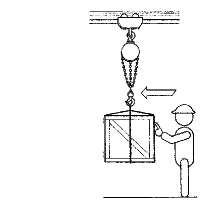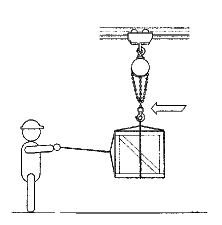Materials Handling - Use of Materials Hoists
On this page
What is a materials hoist?
Back to topA hoist is a device used to lift or move material. The lifting force is provided by a drum (or wheel) on which a rope (wire or fibre) or a chain is wrapped.
There are different types of hoists – Electro-hydraulic, manual or lever operated, base-mounted, or pendant cranes. These hoists are different in the way they move, but the precautions that should be taken when working with them are similar.
Always follow the manufacturer's recommendations for the hoist you are using.
When should you inspect the materials hoists?
Back to top- Daily – Inspect hooks, ropes, brakes and limit switches for wear and damage.
- Before lifting a load – Check the upper and lower hooks to see that they swivel. Replace any worn, damaged, or corroded chain or wire rope immediately. Tag any defective chain or rope and remove it from service.
- Periodically, or as recommended by the manufacturer or applicable legislation. Schedule a detailed inspection of all hoists based on the manufacturer's recommended maintenance schedules.
- Replace items not operating properly. Tag defective items and remove them from service for repair by a competent person.
- Check that the safe load limit is posted on the hoist.
How should you use a materials hoist?
Back to top- Know the safe load limit of the hoist. Do not exceed.
- Keep wire ropes and chains lubricated.
- Hoist from directly over the load. If not centred, the load may swing when lifted.
- Hang hoists solidly in the highest part of the hook area. Rigged this way, the hook support is directly in line with the hook shank.
- Lever-operated hoists can be used to pull in any direction, but a straight-line pull must be maintained. Side pulling or lifting increases wear and sets up dangerous stress levels on hoist parts. Only one person should pull on the hand, chain, and lever hoists.
- When loading the lower hook, place the load directly in line with the hook shank. Loaded this way, the load chain makes a straight line from hook shank to hook shank.

Chain hoist
- Pushing a loaded hoist is safer (A). If it must be pulled, use a rope (B).

A

B
- Stand completely clear of the load.
- Seat the load properly in the hook.
- Move the hoist controls smoothly. Avoid abrupt, jerky movements of the load. Remove slack from the sling and hoisting ropes before lifting the load.
- Remove all loose materials, parts, blocking and packing from the load before starting the lift.
- Make sure everyone is away from the load before starting to hoist.
What should you avoid when using material hoists?
Back to top- Do not use hoisting equipment for lifting or moving people.
- Do not pass a load over workers.
- Do not tip a load. When the load is unstable, it harms the hook and hoist.
- Do not insert the point of the hook in a link of the chain.
- Do not hammer a sling into place.
- Do not leave slings dangling from the load hook. Place sling hooks on the sling ring when carrying slings to the load.
- Do not raise loads higher than necessary to clear objects.
- Do not exceed a hoist load limit.
- Do not leave suspended loads unattended.
- Fact sheet last revised: 2025-11-18

